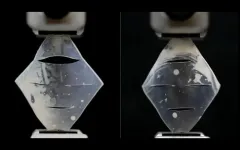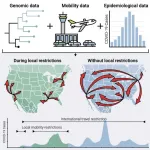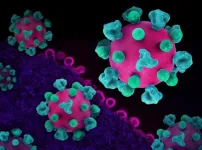(Press-News.org) Researchers from the Harvard John A. Paulson School of Engineering and Applied Sciences (SEAS) have increased the fatigue threshold of particle-reinforced rubber, developing a new, multiscale approach that allows the material to bear high loads and resist crack growth over repeated use. This approach could not only increase the longevity of rubber products such as tires but also reduce the amount of pollution from rubber particles shed during use.
The research is published in Nature.
Naturally occurring rubber latex is soft and stretchy. For a range of applications, including tires, hoses, and dampeners, rubbers are reinforced by rigid particles, such as carbon black and silica. Since their introduction, these particles greatly improve the stiffness of rubbers but not their resistance to crack growth when the material is cyclically stretched, a measurement known as the fatigue threshold.
In fact, the fatigue threshold of particle-reinforced rubbers hasn’t improved much since it was first measured in the 1950s. This means that even with the improvements to tires that increase wear resistance and reduce fuel consumption, small cracks can shed large amounts of rubber particles into the environment, which cause air pollution for humans and accumulate into streams and rivers.
In previous research, a team led by Zhigang Suo, the Allen E. and Marilyn M. Puckett Professor of Mechanics and Materials at SEAS, markedly increased the fatigue threshold of rubbers by lengthening polymer chains and densifying entanglements. But how about particle-reinforced rubbers?
The team added silica particles to their highly entangled rubber, thinking the particles would increase stiffness but not affect fatigue threshold, as commonly reported in the literature. They were wrong.
“It was quite a surprise,” said Jason Steck, a former graduate student at SEAS and co-first author of the paper. “We did not expect adding particles would increase the fatigue threshold but we discovered that it increased by a factor of ten.”
Steck is now a Research Engineer at GE Aerospace.
In the Harvard team’s material, the polymer chains are long and highly entangled, while the particles are clustered and covalently bonded to the polymer chains.
“As it turns out,” said Junsoo Kim, a former graduate student at SEAS and co-first author of the paper, “this material deconcentrates stress around a crack over two length scales: the scale of polymer chains, and the scale of particles. This combination stops the growth of a crack in the material.”
Kim is now an Assistant Professor of Mechanical Engineering at Northwestern University.
The team demonstrated their approach by cutting a crack in a piece of their material and then stretching it tens of thousands of times. In their experiments, the crack never grew.
“Our approach of multiscale stress deconcentration expands the space of material properties, opening doors to curtailing polymer pollution and building high-performance soft machines,” said Suo, senior author of the study.
“Traditional approaches to design new elastomeric materials missed these critical insights of using multiscale stress deconcentration to achieve high performance elastomeric materials for broad industrial uses,” said said Yakov Kutsovsky, an Expert in Residence at the Harvard Office of Technology Development and co-author of the paper. “Design principles developed and demonstrated in this work could be applicable across a wide range of industries, including high-volume applications such as tires and industrial rubber goods, as well as emerging applications such as wearable devices.”
Kutsovsky previously served as Chief Scientific Officer and Chief Technology Officer at Cabot Corporation for 15 years.
Harvard’s Office of Technology Development has protected the intellectual property associated with this project and is exploring commercialization opportunities.
The research was supported in part by the MRSEC grant DMR-2011754 and by the Air Force Office of Scientific Research under grant FA9550-20-1-0397.
END
Rubber that doesn’t grow cracks when stretched many times
Multi-scale approach improves the fatigue threshold of particle-reinforced rubber
2023-12-14
ELSE PRESS RELEASES FROM THIS DATE:
Social distancing was more effective at preventing local COVID-19 transmission than international border closures
2023-12-14
LA JOLLA, CA—Elucidating human contact networks could help predict and prevent the transmission of SARS-CoV-2 and future pandemic threats. A new study from Scripps Research scientists and collaborators points to which public health protocols worked to mitigate the spread of COVID-19—and which ones didn’t.
In the study, published online in Cell on December 14, 2023, the Scripps Research-led team of scientists investigated the efficacy of different mandates—including stay-at-home measures, social distancing and travel restrictions—at preventing local and regional transmission during different phases of the COVID-19 pandemic. They found ...
Custom software speeds up, stabilizes high-profile ocean model
2023-12-14
On the beach, ocean waves provide soothing white noise. But in scientific laboratories, they play a key role in weather forecasting and climate research. Along with the atmosphere, the ocean is typically one of the largest and most computationally demanding components of Earth system models like the Department of Energy’s Energy Exascale Earth System Model, or E3SM.
Most modern ocean models focus on two categories of waves: a barotropic system, which has a fast wave propagation speed, and a baroclinic system, which ...
Can you change a chicken into a frog, a fish or a chameleon?
2023-12-14
Gastrulation is one of the most important phases in early embryonic development. Before gastrulation, vertebrate embryos are simple two-dimensional sheets of cells. By the end of gastrulation, an embryo will have begun to differentiate distinct cell types, set up the basic axes of the body and internalize some of the precursors for organs in a three-dimensional structure. Amniotes, like chickens and humans, will have developed a primitive streak, the precursor to the brain and skin, while fish and amphibians will have developed a spherical-shaped ...
How the immune system fights to keep herpes at bay
2023-12-14
Herpes simplex virus (HSV) is extremely common, affecting nearly two-thirds of the world’s population, according to the World Health Organization.
Once inside the body, HSV establishes a latent infection that periodically awakens, causing painful blisters on the skin, typically around the nose and mouth. While a mere nuisance for most people, HSV can also lead to dangerous eye infections and brain inflammation in some people and cause life-threatening infections in newborns.
Researchers have long known ...
Drones capture new clues about how water shapes mountain ranges over time
2023-12-14
UNIVERSITY PARK, Pa. — Drones flying along miles of rivers in the steep, mountainous terrain of central Taiwan and mapping the rock properties have revealed new clues about how water helps shape mountains over geological time, according to a team led by Penn State scientists.
The researchers found a link between the size of boulders in the rivers and the steepness of the rivers. The link shows how rock properties can influence the relationship between tectonic processes happening deep underground and how mountainous landscapes ...
NIH research identifies opportunities to improve future HIV vaccine candidates
2023-12-14
WHAT:
An effective HIV vaccine may need to prompt strong responses from immune cells called CD8+ T cells to protect people from acquiring HIV, according to a new study from researchers at the National Institute of Allergy and Infectious Diseases (NIAID), part of the National Institutes of Health, and colleagues. The study findings, appearing in Science, draw comparisons between the immune system activity of past HIV vaccine study participants and people with HIV who naturally keep the virus from replicating even in the absence of antiretroviral ...
Can an app improve your romantic relationship?
2023-12-14
Half of all marriages in the United States are likely to fail by the time the spouses reach their 50s. Understandably, many couples are looking for ways to avoid becoming part of that statistic, well aware of a divorce’s possible wide-reaching detrimental effects on families, children, personal finances, individual well-being—and direct and indirect costs to society.
Ronald Rogge, an associate professor of psychology at the University of Rochester, has been researching the complex dynamics ...
Climate-smart ocean planning in Antarctica awarded with 1.5M€ ERC starting grant
2023-12-14
Catarina Frazão Santos, researcher at the Faculty of Sciences of the University of Lisbon (Portugal) (Ciências ULisboa), has been awarded by the European Research Council (ERC) with a Starting Grant of approximately 1.5 million euros to study the benefits and challenges of developing sustainable, equitable and climate-smart marine spatial planning processes in Antarctica and beyond.
“We need to raise awareness and foster a ‘paradigm shift’ on how to plan for sustainability and equity in a changing ocean,” says Catarina ...
Researchers, Coast Salish people analyze 160-year-old indigenous dog pelt in the Smithsonian’s collection
2023-12-14
Researchers from the Smithsonian’s National Museum of Natural History led a new analysis that sheds light on the ancestry and genetics of woolly dogs, a now extinct breed of dog that was a fixture of Indigenous Coast Salish communities in the Pacific Northwest for millennia. Anthropologist Logan Kistler and evolutionary molecular biologist Audrey Lin analyzed genetic clues preserved in the pelt of “Mutton,” the only known woolly dog fleece in the world, to pinpoint the genes responsible for their ...
Diverse gut bacteria communities protect against harmful pathogens by nutrient blocking
2023-12-14
UNDER EMBARGO UNTIL 19:00 GMT / 14:00 ET THURSDAY 14 DECEMBER 2023
Diverse gut bacteria communities protect against harmful pathogens by nutrient blocking
New study demonstrates that diverse communities of resident bacteria can protect the human gut from disease-causing microorganisms.
However, this protective effect is lost when only single species of gut bacteria are present.
The researchers found that protective communities block the growth of harmful pathogens by consuming nutrients that the pathogen needs.
The findings, published today in the journal Science, could help to develop new strategies to optimise gut health.
The ...
LAST 30 PRESS RELEASES:
Numbers in our sights affect how we perceive space
SIMJ announces global collaborative book project in commemoration of its 75th anniversary
Air pollution exposure and birth weight
Obstructive sleep apnea risk and mental health conditions among older adults
How talking slows eye movements behind the wheel
The Ceramic Society of Japan’s Oxoate Ceramics Research Association launches new international book project
Heart-brain connection: international study reveals the role of the vagus nerve in keeping the heart young
Researchers identify Rb1 as a predictive biomarker for a new therapeutic strategy in some breast cancers
Survey reveals ethical gaps slowing AI adoption in pediatric surgery
Stimulant ADHD medications work differently than thought
AI overestimates how smart people are, according to HSE economists
HSE researchers create genome-wide map of quadruplexes
Scientists boost cell "powerhouses" to burn more calories
Automatic label checking: The missing step in making reliable medical AI
Low daily alcohol intake linked to 50% heightened mouth cancer risk in India
American Meteorological Society announces Rick Spinrad as 2026 President-Elect
Biomass-based carbon capture spotlighted in newly released global climate webinar recording
Illuminating invisible nano pollutants: advanced bioimaging tracks the full journey of emerging nanoscale contaminants in living systems
How does age affect recovery from spinal cord injury?
Novel AI tool offers prognosis for patients with head and neck cancer
Fathers’ microplastic exposure tied to their children’s metabolic problems
Research validates laboratory model for studying high-grade serous ovarian cancer
SIR 2026 delivers transformative breakthroughs in minimally invasive medicine to improve patient care
Stem Cell Reports most downloaded papers of 2025 highlight the breadth and impact of stem cell research
Oxford-led study estimates NHS spends around 3% of its primary and secondary care budget on the health impacts of heat and cold in England
A researcher’s long quest leads to a smart composite breakthrough
Urban wild bees act as “microbial sensors” of city health.
New study finds where you live affects recovery after a hip fracture
Forecasting the impact of fully automated vehicle adoption on US road traffic injuries
Alcohol-related hospitalizations from 2016 to 2022
[Press-News.org] Rubber that doesn’t grow cracks when stretched many timesMulti-scale approach improves the fatigue threshold of particle-reinforced rubber







